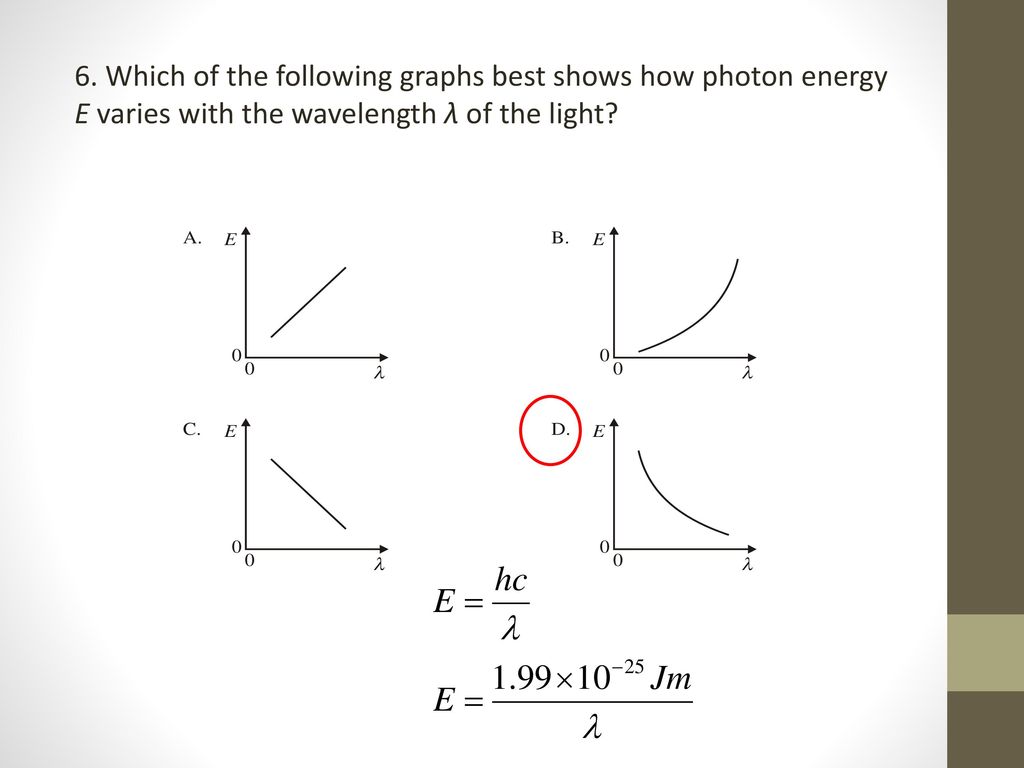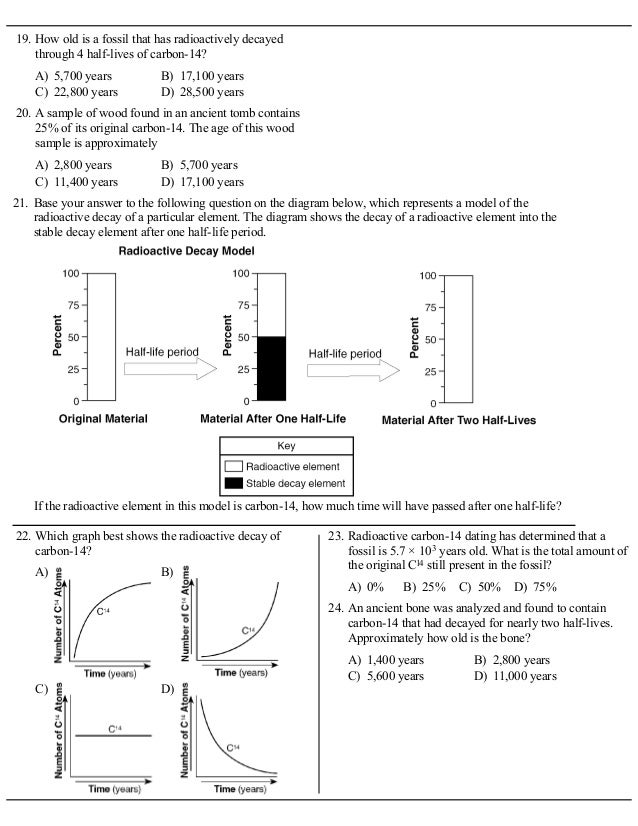Which Graph Best Shows the Radioactive Decay of Carbon 14
The graph represents the decay of. Particles released during radioactive decay can have different energies.
Part of the table has been deliberately left blank for student use.

. Which graph best shows the radioactive decay of carbon-14. Nitrogen-14 decay product resulting from the radioactive decay. The graph shows that 50 percent of the carbon-14 atoms have decayed after 5730 years so 5730 is the half-life of carbon-14.
A suitable unit for these energies is MeV. 34- Lead 12 12- Uranum 14- 14- 2 3 Number of Hal-lves 2 3 Number of Hall-ves 1 3 44 44 34 34 Urankm Lead 12 12- Leed 14 14 Uranum 1 3. The diagram below represents the radioactive decay of uranium-238.
Differentradioisotopes have different half-lives. Carbon-14 or radiocarbon is a radioactive isotope of carbon with an atomic nucleus containing 6 protons and 8 neutrons. The graph shows how far the particles with these energies travel in air.
Half-life Mass of Original Carbon-14 Remaining grams Number of Years 0 1 0 1 1 2 5700 2 1 4 11400 3 1 8 17100 4 1 16 5 6 7 After how many years will 1 128 gram of the original carbon-14 remain. The same rules still apply. Base your answer to the question on the graph below and on your knowledge of Earth science.
Students graphs should be identical to the graph for carbon-14 but the labels on the. Use the following graph to answer questions 8-11. This is how carbon dating works and its used to determine how.
In the plot above 100 appears to come halfway between 10 and 1000. Some of that carbon-12 gets exposed to cosmic radiation and turns into carbon-14 which has eight neurons. If I start out with 20 grams of carbon-14 and wait about 5730 years the half-life of carbon-14 around 10 grams will remain and 10 grams will have been converted into nitrogen-14 thats the product of a carbon-14 atom that underwent beta decay.
Decay rates of radioactive substances such as these can be used to determine the age of rocks and fossils because radioactive decay occurs 1 at a steady predictable rate 2 in all types of sedimentary rock. Refer to the reading passage and graph in this printable to answer questions about the half-life of radioactive elements. Which graph best represents the radioactive decay of uranium-238 into lead-206.
Figure 14 Radioactive decay of carbon-14. Students will interpret the decay of carbon-14 and graph the decay of uranium-238. If a sample known to be.
The age of which index fossil could be determined by using carbon-14. The rate at which a radioactive isotope decays is measured in half-life. Ratio of initial active nuclei in two different samples is 23.
Its presence in organic materials is the basis of the radiocarbon dating method pioneered by Willard Libby and colleagues to date archaeological geological and hydrogeological samples. 1 1 x 103 years 3 10 x 103 years 2 5 x 103 years 4 40 x 103 years 5. The graph below shows the decay of a radioactive material over time.
Semilog plots are pretty tricky because the vertical axis has funny spacing. Not only does it decay by giving off energy and matter but it also decays at a rate that is characteristic to itself. Used to date animals and plant and has a half life of a 5730 years.
A bar graph of the radioactive decay of carbon-14 is shown below. How long is a half-life for carbon-14. What is the total amount of the original C14 still present in the fossil.
Used to date oldest rocks more than 10 mill. Which graph correctly shows the accumulation of nitrogen-14 the decay product of carbon-14 over the same period. How long does it take for this radioactive material to decay through 2 half-lives.
The graph below shows the decay of a radioactive material over time. A bone fragment found in a cave contains 02 times as much 614 C as an equal amount of carbon in the air when the organism containing bone diedThe approximate age of fragment is t21 of 614 C 5730 years Hard. Radioactive carbon-14 dating has determined that a fossil is 57103 years old.
Which graph correctly shows the accumulation of nitrogen-14 the decay product of carbon-14 over the same period. The solid black sections of the bars on the graph represent the percentages of. Carbon-14 is radioactive with a half-life of 5700 years.
Another type of graph that scientists like to use to show nuclear decay data is a semilog plot shown below Mass versus time graph with the half-life indicated by a red dot. 057 114 171 22 Tme x10 yr 2 4 Copyright 2017 Topical Review Book Company Radioactive Deca Percentage of N. Radioactive Decay HW 3 Section.
Base your answers to the following questions on the Earth Science Reference Tables the graph below and your knowledge of Earth science. Nonmetals Metalloids and Radioactive Elements The Decay of Carbon-14 Enrichment Activity 1. Undecayed radioactive uranium-238 b.
The graph shows the decay rates of four radioactive substances A B C and D. If only 25 of the carbon-14 remains how old is the material containing the carbon-14. Base your answers to the following questions on the.
1 carbon-14 2 potassium-40 4 rubidium-87 6 3 uranium-238 7. A 655-million-year-old impact crater in Mexico provides evidence for the cause of the. Which graph best represents the radioactive decay of uranium-238 into lead-206.
The term half-life is defined as the time it takes for one-half of the atoms of a radioactive material to disintegrate. Earth Science Reference Tables and the graph below. A graph of the radioactive decay of carbon-14 is shown.
Carbon-14 was discovered on February 27 1940 by Martin Kamen. So what makes this useful. The graph shows the percentages of the radioactive isotope carbon-14 14 C and its disintegration product produced during four half-lives of radioactive decay.
The absolute age of an igneous rock can best be determined by. Historically knowndatable points Ptolemaic period in Egypt permited researchers toverify the concept of radiocarbon dating. Up to 24 cash back 4.
The Decay of Carbon-14. If a sample originally had 240 atoms of carbon-14 how many atoms of carbon-14 will remain after 17 190 years. For one type of decay the particles released have energies between 40 MeV and 100 MeV.
Shaded areas on the diagram represent the amount of. Years old The absolute age of a rock is the approximate number of years ago that the rock formed. Plot of carbon-14 decay rate against ageof the sample in years.
The table below gives information about the radioactive decay of carbon-14. 12 100 75- 75 60 25 25 57 114 17 J 228 Time x10 yr 0 57 114 17 228 Tme x10 y 1 3 100 100 75 50 25 657 114 17J 220 Time x10 yn.

Apes Midterm Flashcards Quizlet

The Graph Below Shows The Radioactive Decay Of Some Unknown Substance Below The Graph Is A Table With A List Of Different Radioactive Substances And Their Half Lives The Graph Best

Unit 8 Astronomy Review Ppt Video Online Download

Unit 7 Review Quiz 2 Solutions Ppt Download

Earth Science Final Flashcards Quizlet

The University Of The State Of New York

Decay Graphs And Half Lives Article Article Khan Academy

Unit 8 Astronomy Review Regents Earth Science Miss

March 3rd Historical Geology Test Flashcards Quizlet

Physics Revision Gcse And A Level Physics Revision Cyberphysics The Revision Website


Comments
Post a Comment